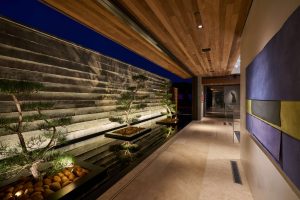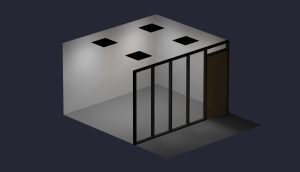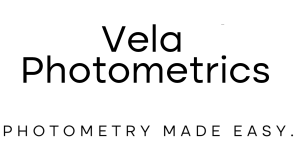Below is a list of key terms used in lighting design and simulation. New industry technologies and trends constantly bring about new terminology and this glossary will grow to reflect such developments.
Accent Lighting
Accent lighting highlights specific objects and features, allowing them to stand out. Besides being employed for purely decorative purposes, accent lighting can also act as a valuable tool in a retail setting.
Ambient Lighting
General artificial and natural lighting that provides visibility in built environments. Ambient lighting excludes task and accent lighting and could be described as subtle, soft, and in the background.
American National Standards Institute (ANSI)
An organization that sets voluntary consensus standards for products, personnel, systems, services, and processes within the United States as well as coordinating their use abroad.
Angle of Incidence (of light reflection)
The angle of a ray of light hitting a surface. According to Fresnel’s Law, if this surface is smooth, the reflected ray of light will have the same angle as the incident ray. An angle of zero degrees is perfectly perpendicular to the surface and sometimes referred to as “normal incidence.”
Angle of Light
The angle between a light source direction and the viewer’s line of sight.
Backlighting
A form of accent lighting popular with works of art whereby the light source illuminates an object from behind, thus creating a glowing effect. While this type of fixture may sometime be called a backlight, it is important to note that this term also has another definition (see below).
Backlight
Outdoor lighting that is emitted in the opposite direction intended by the fixtures. This can cause lighting pollution problems at night and for this reason outdoor fixtures often include a house shield.
Beam Angle (or Beam Spread)
A measure of the angle of a downward light cone being emitted by a light fixture with a reflector.
Baffle
A trim found in lighting fixtures (most commonly recessed lighting) that reduces glare and softens the effects of light. Note: the term “baffle” also refers to ceiling features that are usually linear, free-hanging, and function to dampen acoustics.
Brightness Contrast (Light-Level Contrast, Contrast)
A key component of lighting design and creating a visual hierarchy, brightness contrast can achieve design goals by providing certain parts of a space with more light and others with less or no light. Brightness contrast creates what is known as the “moth effect.”
Often simply referred to as “contrast” in lighting design, it is only a distinct part of luminance contrast (achromatic contrast) and differs from chromatic contrast, both of which can be used to discuss the contrast of surfaces and materials (rather than light source intensities). Achromatic and chromatic contrasts are concepts that apply to wider fields of design while also being valuable considerations in lighting design.
BUG Rating
An acronym representing three lighting characteristics that describe the amount of light being emitted in unwanted directions: Backlight, Uplight, and Glare. This scale, developed by the Illuminating Engineering Society and the International Dark-Sky Association (IDA) has a format that looks like Bx Ux Gx, where x is a number on a 0 to 5 scale, with 0 being the best and 5 being the worst.
Candela (cd)
The International System of Units (SI) base unit for measuring luminous intensity.
Chromatic Contrast
Chromatic contrast refers to the difference in color between materials and is based on brightness, hue, and saturation. It is much more broad than luminance contrast (sometimes called achromatic contrast), which only covers greyscale differences in brightness (intensity). Chromatic contrast is not the first type of contrast that lighting designers typically think about, but its consideration is useful in lighting design decisions.
Coefficient of Utilization (CU)
How much of a lamp’s luminous output reaches the work plane. This fractional number is not only influenced by a fixture’s luminous efficiency, but also by an environment’s shape and colors.
Color Rendering Index (CRI)
A measurement of how accurately a light source represents the true colors found within an environment. Lamps with higher CRI values are crucial to areas of lavish detail and décor. Natural light (the sun) has a perfect CRI score of 100.
Construction Administration (CA) Phase
After the Contract Documents (CD) Phase, comes the final phase of the architectural design process. In the Construction Administration Phase, contractors provide submittals to verify with the architects and engineers that their work will be in line with the intended design. In this phase, substitutions in products and processes are considered to save money (known as value engineering). Construction is realized by contractors and is reviewed periodically by the architects and engineers.
Contract Documents (CD) Phase (or Construction Documents Phase)
The Contract Documents Phase occurs after the Design Development (DD) Phase. At this point, architects and engineers have finalized specifications and drawings to the point where they can be stamped and moved forward for permitting, bidding, and construction. After the contract documents phase is the Construction Administration (CA) Phase.
Correlated Color Temperature (CCT)
A numerical representation of a light fixture’s color output. For example, while a 2700K fixture has a warm, relaxing yellow, a 6500K fixture has a blue, energizing effect. A 4000K CCT represents a neutral white fixture. CCT is often also referred to simply as “color temperature,” but it is important to note that this is not a fixture’s operating temperature.
Cutoff Angle
The angle at which a light source is no longer able to be seen directly. This is measured from the direction directly below the lamp.
Design Development (DD) Phase
The Design Development Phase follows the Schematic Design (SD) Phase of an architectural and/or lighting design project. A desirable approach chosen from the Schematic Design Phase’s artistic renderings is clarified; this is done by setting engineering specifications and the creation of mockups, physical models, and scaled architectural drawings. The Design Development Phase is followed by the Contract Documents (CD) Phase.
Diffuse Reflected Light
Reflected light that goes in a variety of directions after hitting a rough surface. It is one of two types of reflected light, the other being Specular Reflected Light. See Types of Reflection: Specular and Diffuse to visualize their differences.
Diffused Light
Light that has been softened and distributed in a more uniform fashion by bouncing off the many angles of a rough surface (diffuse reflection) or by traveling through a substance that changes its angles (direct diffusion).
Diffuser
A glass or acrylic piece that scatters a light source’s emission, creating a more soft and uniform light with less glare.
Direct Lighting
The result of directing 90% or more of lighting from one or more light sources to the area that is desired to be illuminated. This differs from the other popular technique, indirect lighting.
Ellipsoidal Reflector Lamp (ER Lamp)
A form of entertainment/stage lighting that collects and directs light through a barrel containing one or more lenses.
Emergency Lighting
Any lighting that runs on a battery backup and is designed to provide lighting during blackouts.
Foot-Candle (fc)
A non-SI unit of illuminance that is popular in the United States. A foot-candles is defined as one lumen per square foot.
Fresnel Effect
The Fresnel Effect describes how the intensity of a surfaces reflection changes depending on the angle it is viewed from; the sharper the viewing angle, the stronger the reflection. For example, you can see a stronger reflection in a swimming pool if you crouch down beside it and look at the water rather than standing directly over it and looking at the water.
Glare
The visual impairment caused directly from a light source or by its reflection. Glare can disable the viewer’s ability to distinguish objects easily or even cause enough discomfort that the viewer is forced to look away.
Glazing
Glazing refers to architectural glass elements such as curtain walls, windows, and glass partition walls. Glazing types can vary widely to meet durability, privacy, energy efficiency, and light quality goals. Different types of glazing have different properties of lighting transmission, reflection, and absorption.
Goniophotometer
A goniophotometer is a device used to capture light being emitted from a light source at a specific angle; this makes it a good tool for capturing luminous intensity. Photometric data files can be created using a goniophotometer.
House Shield
An accessory added to streetlamps to prevent unwanted backlight and unnecessary light pollution.
Illuminance
Commonly measured in either lux or foot-candles, illuminance is the amount of luminous flux striking a surface per unit of area. Greater illuminance improves visibility, and environments require different levels of illuminance depending on their intended use. To see recommended levels of illuminance based on area use, please take a look at Vela Photometric’s guide.
Illuminating Engineering Society (IES)
The Illuminating Engineering Society (IES) was founded in 1906 with the purpose of defining and communicating ideal practices in lighting design. Many of its publications have been adopted by the American National Standards Institute (ANSI) and its own .ies file format is an industry standard for realizing fixture outputs in 3D computer simulation.
Indirect Lighting
A technique of reflecting a light source off of surfaces to light up an area. This is opposed to the practice of direct lighting.
Initial Lumens
The lighting output of a brand new light fixture.
Ingress Protection (IP) Rating
A rating system that represents a device’s resistance to both solid particles and liquids. The rating is represented as IPxy, where x represents particle solid protection and y represents liquid protection. A higher number represents better protection in both parts of the rating.
Integrating Sphere
An integrating sphere is a spherical chamber painted on the inside with a diffuse, white, reflective paint. Because its surfaces create a uniform reflection throughout the chamber, it can measure the luminous flux (total light output) of a light source. This uniform capture of light means it can’t directly measure luminous intensity, which is angle-dependent and often measured using a goniophotometer. Integrating spheres are also used to measure the light reflectance values of materials.
Inverse Square Law
A scientific law that is applicable to the calculation of illuminance. According to the law, the illuminance of a surface is inversely proportional to the squared distance of the the surface from the light source. The accuracy of this law is affected by factors such as light source size and distribution.
Kelvin(K)
The base unit for measuring temperature when using the International System of Units (SI), Kelvin is also used to describe the color of lighting (see Correlated Color Temperature). This is based on the colors that would be emitted by a black body when heated to a certain temperature.
Lamp Lumen Depreciation (LLD)
A factor that represents the progressive reduction of a light fixture’s luminous output over its service life.
Light Loss Factor (LLF)
A factor that represents an estimated output from a light fixture after subtracting factors such as lens degradation and dust build up from its initial lumens.
Light Pollution
Light output emitted into unintended directions and/or at unnecessary times.
Light Reflectance Value (LRV)
The light reflectance value is the amount of light that is reflected from a surface, represented as a percentage or its decimal equivalent. Many paint, finish, and other material manufacturers have this value readily available on their website or product data sheet.
Lighting Power Density (LPD)
A measure of watts per area (typically watts/ft² in the United States), the Lighting Power Density represents the electrical load of luminaires in a defined area. This value excluded any dimming values unless otherwise specified.
Louver
A screen that is put over a light to diffuse its emission, eliminating glare.
Luminaire Dirt Depreciation (LDD)
Progressive decrease in a fixture’s emissions due to dust and dirt build up.
Luminaire Efficiency
The ratio of lumens emitted by an entire lighting fixture to the individual lighting sources within. Some lighting is always lost as a result of fixture geometry and reflection,
Luminance
A measure of the amount of light that is reflected from a space or object that is being illuminated. Luminance is dependent on the viewing angle.
Luminance Contrast (Achromatic Contrast)
Luminance contrast is the difference in light intensity (brightness) between spaces or objects. A higher luminance contrast could be achieved by adding/removing light sources (this is the most commonly thought of “contrast” in lighting design) or increasing the grayscale light reflectance value (LRV) contrast between materials (For example, a black rug on a marble floor would create a much stronger luminance contrast than a light gray carpet). The latter choice falls outside of lighting design since the contrast was changed without considering light sources. Luminance contrast differs from chromatic contrast because it does not consider properties of color.
Lumens
The SI unit for measuring luminous flux, which tells us the quantity of visible light emitted from a light source.
Luminous Flux
Measured in lumens, the luminous flux represents the total quantity of visible light emitted from a light source in all directions. It is often measured using an integrating sphere.
Luminous Intensity
Measured in candelas, luminous intensity represents the luminous output of a source relative to a specific direction; it changes with the viewing angle. It is often measured using a goniophotometer.
Lux
A International System of Units (SI) unit of illuminance. One lux is defined as one lumen per square meter.
Mean Lumens
The average light output produced by a fixture for the duration of its rated life.
Monochromatic Light
A single wavelength source of light. For example, low-pressure sodium lamps only put out a dull, yellow, single wavelength emission.
Moth Effect
The tendency of the brightest thing in a space to be the first draw of attention. This is a useful rule of visual hierarchy in lighting design, and the effect can be amplified with contrast (by increasing light on the object or removing surrounding light).
Mounting Height
Usually represented as the distance between the bottom of the fixture and the ground, it is some instances also specified as the distance between the bottom of the fixture and the work plane.
Photometric Data File
A photometric data file is a 3D representation of a light source’s output (specifically, its luminous flux and luminous intensity). Photometric data files are essential to running computer-aided light simulation and most commonly come in .ies file format. There are also other existing file formats, as well as other ones being developed to overcome existing limitations.
Photometry
The science of measuring light through space and materials.
Photopic Lumens
A unit for measuring light output according to human daylight vision.
Reflectance
An object or surface’s reflectance is the ratio of reflected light to incident light. This is often represented as a Light Reflectance Value (LRV). Reflection is typically described as specular or diffuse. Read Types of Reflection: Specular and Diffuse to visualize their differences.
Saturation
The level that color is either intensified or dulled as a result of a light source hitting an object or surface, when compared to it’s color when exposed to natural lighting.
Scotopic Lumens
A unit for measuring light output according to human nighttime vision. In the past, the measurement of light focused on daytime vision. An increased interest on measuring scotopic lumens has aided the industry in more efficiently lighting nighttime environments (especially outdoors).
Schematic Design (SD) Phase (or Conceptual Design Phase)
The Schematic Design Phase is the first visualization design phase in an architectural and/or lighting design project. Initial information such as client preferences, usage patterns, and site context is taken into account, along with decorative, emotional, and functional goals, to create artistic renderings and inspirational photos. The Schematic Design Phase is followed by the Design Development (DD) Phase.
Scotopic/Photopic (S/P) Ratio
A unit for measuring light output according to human nighttime vision. In the past, the measurement of light focused on daytime vision. An increased interest on measuring scotopic lumens has aided the industry in more efficiently lighting nighttime environments (especially outdoors).
Specular Reflected Light
Light that is reflected at the same angle as the incident angle striking a mirror-like, shiny surface. It is one of two common categories of reflected light, the other being Diffuse Reflected Light. See Types of Reflection: Specular and Diffuse to visualize their differences.
Task Lighting
Light fixtures placed in areas where visibility is needed to perform specific tasks. For example, lighting placed to improve visibility on a desk, kitchen counter, or laboratory equipment.
Uniformity
Lighting uniformity describes how consistent illuminance levels are throughout a given area. Having high lighting uniformity is desirable in spaces where the lighting design focuses on functionality, for example, in offices, basketball courts, and parking lots. Low uniformity can work well in places that focus on decorative lighting and accenting only certain features. Lighting Uniformity is measured using a calculated area’s Avg/Min or Max/Min; see Vela’s guide on reading point by point illuminance calculations to learn more.
Visual Hierarchy
Visual hierarchy is a concept found throughout visual design where variations in scale, contrast, color, alignment, and proximity allow certain elements stand out more than others. In lighting design, the strongest tool of visual hierarchy is brightness contrast.
Updated on September 12, 2024




